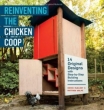Land and fencing for poultry
You will probably want to give your hens as much freedom as possible. However, remember free-range hens are vulnerable to predators. Hens are also great foragers and dust bathers and as such can wreak havoc in your garden. There are two alternatives – a fixed pen and a mobile ark. In either case, you can let the hens out to roam further if you are around to supervise.
Mobile arks
The mobile ark is very useful for small numbers of hens. It can be moved every day or so to give access to fresh grass; in winter, you can put it on your vegetable beds and the hens will eat any seeds and bugs that are around. Ideally, you should have enough space for a three-week rotation, to reduce worm infestation.
When we had three hens, they were kept in the small ark and extension run all the time, but seemed to have lots of room. The ark and run were moved each evening once the hens had gone to roost, so the hens had access to fresh grass every day.
Fixed runs
If you want to have a fixed run, allow at least 4 square metres per hen. Ideally, split the run into two so that each area can be used and rested in turn. A top dressing of hydrated lime (garden or agricultural lime made from pulverised limestone or chalk) on the resting area will counteract the acidity of the hen droppings and reduce worm infestation but hens must be kept off the area for at least two months. Adding a proprietary product such as Stalosan or Biosuper will help the disinfection process.
Putting slatted wood, gravel or slabs at the entrance to the house will prevent the area getting muddy and becoming a potential source of disease.
Ensure that any type of roofed run (and house), particularly triangular ones, has sufficient headroom for large fowl and cockerels in particular.
A base of straw or bark will protect the soil and give the hens something to scratch in; a freestanding dust bath can be introduced, filled with wood ash or compost, along with some stout tree branches that will not only harbour tasty bugs but will provide a natural perching area.
Hens don’t mind the wet too much, but they don’t like wind, so try to incorporate some shelter into the run.
Fencing for poultry
Your fencing will need to be high enough to keep you hens in and deter predators – so at least 1.8m high. Sinking the wire either 30cm below the soil or laying it on the ground outside the pen will deter predators from digging in, but do check regularly for unsuccessful attempts at entry. An outward sloping overhang at the top will also help to deter foxes.
You may need to clip your hens’ wings to keep them in; in fact, you only clip one wing, to unbalance them. Stretch out the wing and cut the ends off the long flight feathers. Take care not to cut too far and remember the feathers do grow back after moulting so the exercise will have to be repeated.
- Previous « Cleaning poultry housing
- Next Plants poisonous to poultry »

About Rosemary Champion
Rosemary lives on a 12 acre smallholding in Angus, in the east of Scotland, where she keeps Ryeland Sheep, Shetland cattle and assorted poultry. She was destined to be a smallholder from an early age.
Further Reading
 Chicken & Eggs: River Cottage Handbook No.11 Mark Diacono |  Storey's Guide to Raising Chickens Gail Damerow |  A Beginners Guide to Caring for Ex-Batts Jo Barlow |  Reinventing the Chicken Coop Matthew Wolpe |  Chickens: The Essential Guide to Choosing and Keeping Happy, Healthy Hens Suzie Baldwin |
Smallholding shop
When you click links below and make a purchase, this may result in this site earning a commission from eBay.

No 5 Poultry Fountain Drinker 4.5li
Eltex Poultry Fountain… from £35.12 + p&p

Pressed Pulp Egg Box - 6 eggs - pk24
Plain grey pressed… from £4.00 + p&p

Hen House Freshener 2kg
Keep those ammonia smells away… from £11.95 + p&p

Plastic Poultry Feeder 3kg
Super Feeder Hoppers. Capacity… from £6.40 + p&p
















